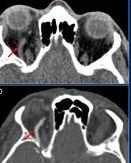Carotid-cavernous sinus fistula associated with uncontrolled hypertension
Keywords:
CAROTID-CAVERNOUS SINUS FISTULA, HYPERTENSION, CAROTID ARTERIES, DOWN SYNDROMEAbstract
Introduction: carotid-cavernous fistula is the abnormal communication between the carotid arteries and the cavernous sinus that provokes variable ocular association.
Case report: a 55-year-old male patient with a history of Down syndrome and chronic hypertension who spontaneously developed proptosis of the right eye and was referred to the neuro-ophthalmology clinic. After a meticulous ophthalmological examination and supported by neuro-imaging studies, a diagnosis of carotid-cavernous fistula of the right eye of low flow was reached.
Conclusions: a patient with a low-flow carotid-cavernous fistula associated with poorly controlled hypertension was reported, an uncommon clinical condition that should be considered during the assessment of a patient with proptosis not associated with external trauma or surgery.
Downloads
References
1. Charlin ER, Pacheco BP, Villarroel WF, Urbina AF. Fístula carotideo-cavernosa: Importancia de su diagnóstico y tratamiento oportuno para prevenir la ceguera. Rev Méd Chile [internet]. 2004 [citado 2017 nov 20]; 132: 1221-6. Disponible en: http://www.scielo.cl/scielo.php?script=sci_arttext&pid=S0034-98872004001000010
2. Ramírez Pérez E, Abreu Leyva A. Fístula carótido cavernosa. Revista Electrónica Dr. Zoilo E. Marinello Vidaurreta [internet]. 2017 [citado 2017 nov 20]; 42(3). Disponible en: http://revzoilomarinello.sld.cu/index.php/zmv/article/view/1036/pdf_408
3. Batún-Garrido JA, Hernández-Núñez E. Fístula Carótido-cavernosa. Medicina Interna de México Vidaurreta [internet]. 2017 [citado 2017 nov 20];30(5):607-12. Disponible en: http://www.medigraphic.com/pdfs/medintmex/mim-2014/mim145n.pdf
4. Lang Serrano G. Fistulas carótdo cavernosa. Medicina Legal de Costa Rica. Edición Virtual [internet]. 2014 [citado 2017 nov 20]; 31(1). Disponible en: http://www.scielo.sa.cr/scielo.php?script=sci_arttext&pid=S1409-00152014000100015&lng=en&nrm=iso&tlng=es
5. Fuentes Pelier D, Alba Carcasés Y, Hodelín Fuentes D. Importancia del método clínico en el diagnóstico de la fístula carótido-cavernosa. MEDISAN [internet]. 2016 [citado 2017 nov 20]; 20(12). Disponible en: http://scielo.sld.cu/scielo.php?script=sci_abstract&pid=S1029-30192016001200011
6. Vilela Pereira MA. Carotid-cavernous fistula. Rev. bras.oftalmol [Internet]. 2013 Fev [citado 2017 nov 20]; 72( 1 ): 70-75. Disponible en: http://www.scielo.br/scielo.php?script=sci_arttext&pid=S0034-72802013000100015&lng=pt.
7. Paredes I, Martínez Pérez R, Munarriz P, Castano-Leon AM, Campollo J, Alén JF, Lobato RD, Lagares A. Fístulas durales arteriovenosas intracraneales. Experiencia con 81 casos y revision de la literature. Neurocirugía [internet]. 2013 [citado 2017 nov 20]; 24(4):141-51. Disponible en: http://www.sciencedirect.com/science/article/pii/S113014731300047X
8. Mesa J.C., Mascaró F., Muñoz S., Prat J., Arruga J.. Abordaje orbitario para el tratamiento de la fístula carótido-cavernosa. Arch Soc Esp Oftalmol [Internet]. 2008 Dic [citado 2017 Nov 24]; 83( 12 ): 720-722. Disponible en: http://scielo.isciii.es/scielo.php?script=sci_arttext&pid=S0365-66912008001200007&lng=es.

Published
How to Cite
Issue
Section
License
Authors who have publications with this journal agree to the following terms: Authors will retain their copyrights and grant the journal the right of first publication of their work, which will be publication of their work, which will be simultaneously subject to the Creative Commons Attribution License (CC-BY-NC 4.0) that allows third parties to share the work as long as its author and first publication in this journal are indicated.
Authors may adopt other non-exclusive license agreements for distribution of the published version of the work (e.g.: deposit it in an institutional telematic archive or publish it in a volume). Likewise, and according to the recommendations of the Medical Sciences Editorial (ECIMED), authors must declare in each article their contribution according to the CRediT taxonomy (contributor roles). This taxonomy includes 14 roles, which can be used to represent the tasks typically performed by contributors in scientific academic production. It should be consulted in monograph) whenever initial publication in this journal is indicated. Authors are allowed and encouraged to disseminate their work through the Internet (e.g., in institutional telematic archives or on their web page) before and during the submission process, which may produce interesting exchanges and increase citations of the published work. (See The effect of open access). https://casrai.org/credit/


